What the ... ?
Spring is here in Back Swamp, South Carolina. Almost every plant around the house is blooming—azalea, blueberry, camellia, spirea, redbud, black cherry, even the darn yellow jessamine. I was laid up by pollen allergies last week, but it was very nice looking out the window, albeit longingly.
A pop of antihistamine and our now well-acquainted online meeting platforms (Zoom, GoToMeeting, Microsoft Teams, what have you) allow me to continue my usual spring speaking circuit. It’s usually during and after my talks when I get a bunch of requests to "identify stuff” by pictures.
There are more questions about this one weird fungus-like growth on tree trunks or branches this spring. Like this one on a cabbage palm trunk in Myrtle Beach, South Carolina:
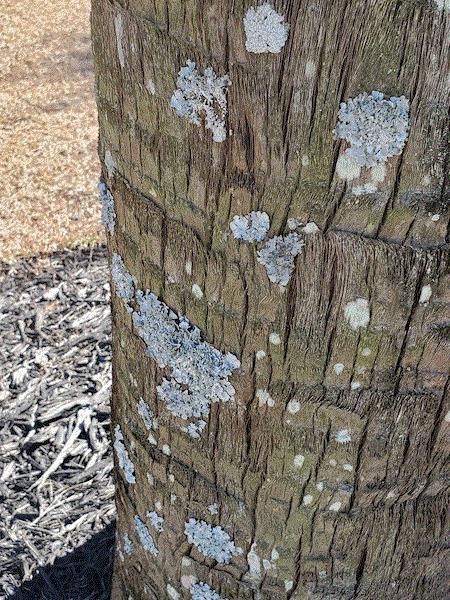
I see them everywhere I turn, so it’s not necessarily spring or location that matters. Perhaps folks are just out a bit more and notice the weird growth on the exposed trunks.
What is this weird growth?
(By the way, I’m not trying to rub in the faces of y’all who may have snow and freezing rain for company this week. Okay, maybe a little ...)

Watch for Ambrosia Beetles
With spring also comes my usual warning about ambrosia beetles, especially for folks who grow trees (containerized or in-ground) for a living. For those who aren’t familiar, ambrosia beetles are small beetles that bore into tree trunks. The tunnels created by these beetles can be a concern, but the more serious damage actually comes from the tree-killing fungi transmitted by the beetles. The beetle has to carry the fungi because beetle grubs feed on the fungi (not on the wood) that are “cultivated” in the tunnels.
The current management approach is to spray pyrethroids (usually bifenthrin or permethrin) on tree trunks to protect them from attacks. It’s game over once the beetles enter the trunk and deposit fungal spores in the tunnels. Trunk sprays usually start when the first beetle is captured in ethanol-baited traps in the spring and ends when the trees have flushed.
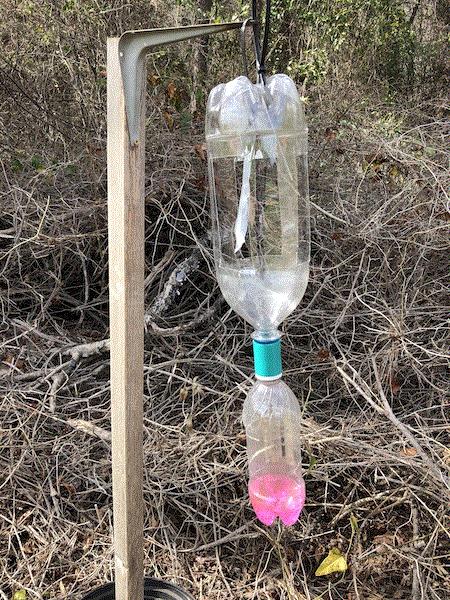
A soda bottle trap baited with an ethanol pouch does wonders for timing insecticide sprays against ambrosia beetles.
This management approach can tremendously reduce the frequency of attacks and tree losses, but there are also a lot of improvements that can still be made. I’m lucky enough to be a part of a research team looking to do just that.
With funding from the USDA Specialty Crop Research Initiative, and with members hailing from Alabama and Georgia to Ohio and New York, this team will study the biology and ecology of ambrosia beetles (so that a risk prediction model can be developed), improve the monitoring and trapping methods, identify new insecticides, plant defense elicitors and biological control agents that can work better than the pyrethroids, develop new management tools (such as wrapping) and push-pull strategies, and understand the economics of the new management tools.
More results and a real-time monitoring network will be in the coming months and I’ll be sure to keep y’all updated.

Syngenta Introduces Postiva Fungicide
Postiva is a combination of difenoconazole and pydiflumetofen (FRAC 3 + 7). The product is registered for use on ornamental plants and certain vegetables in nurseries, Christmas tree farms, greenhouses, landscapes, and interiorscapes. The restricted entry interval (REI) is 12 hours. PPE includes overalls, chemical-resistant gloves, and shoes plus socks.
Postiva can be used against a wide range of diseases when applied as foliar spray and drench. Targets for foliar spray include Botrytis, powdery mildew, Boxwood Blight, Anthracnose, leaf spot, flower blight, rusts, scabs and phorma. Foliar spray can also suppress bacterial diseases caused by Pseudomonas and Xanthomonas. Foliar spray rates range from 10 to 28 fl. oz. per 100 gallons. Medium drench at 10 to 28 fl. oz. per 100 gallons targets root diseases caused by Fusarium, Rhizoctonia, Sclerotinia and Ralstonia.
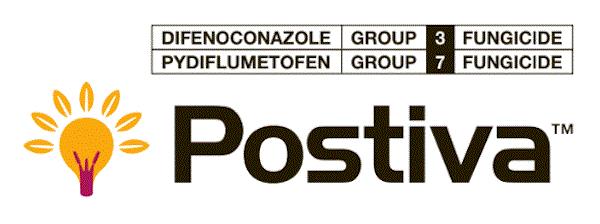
Click HERE for more information on Postiva, including results from some experiments. If you’re good at digging through data, make sure to visit the IR-4 Environmental Program Research Database to check out the efficacy of Postiva against Botrytis, cylindrocladium root rot, Fusarium wilt, Pseudomonas bacterial blight, Rhizoctonia and black root rot. (Select “Postiva” from the “Product” drop-down list.)
The IR-4 Environmental Horticulture Program published a summary of the crop safety of Postiva in June 2021. IR-4 completed 24 crop safety trials on 11 plant species or genera in 2009 and 2020. A foliar spray and drench with Postiva at label rates didn’t cause significant injury to any of the tested species in these experiments. Celosia is mentioned as being sensitive to foliar application on the label. For a copy of the IR-4 Postiva crop safety summary, click HERE.

HRI Awards Research Grants
For 60 years, the Horticultural Research Institute (HRI) has directed, funded and communicated research that benefits the green industry. Do you use the Best Management Practices for Boxwood Health in the Landscape or the Best Management Practices for Bee Health in the Horticultural Industry? HRI did that.
Funding from HRI has made possible research that directly benefits our industry. Thirteen research projects received grants, totaling $417,039, from HRI in 2022.
A grant was awarded to Justin Hollander of Tufts University under the "Quantifying Plant Benefits" category to improve our understanding of how the human mind responds to plants and how such unconscious responses may improve cardiovascular health and wellbeing. This project will utilize biometrics—technologies that measure human biological and physical characteristics—to make capturing a large amount of data possible.
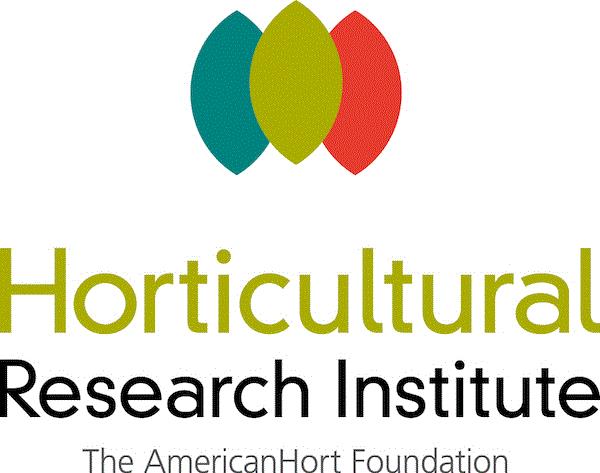
Three grants were awarded under the "Creating Innovative Solutions" category. The first one is awarded to Scott Merkle of the University of Georgia to create ash cultivars that are resistant to emerald ash borer by propagating lingering ash, which are ash trees that survived the assaults.
Another grant was awarded to Haiying Liang of Clemson University to study how a soil-borne bacterium, Agrobacterium rhizogenes, stimulates rooting. The project goal is to develop solutions for propagating woody plant species that are difficult to root.
And Thomas Gianfagna of Rutgers University was awarded a grant to conduct research on evaluating the potential of tulipalin lactones, which can be extracted from tulip bulbs left over from cut flower harvest, as a biofungicide against Botrytis.
Under the "Gathering Consumer Insights" category, a grant wass awarded to Alicia Rihn at the University of Tennessee to understand consumer demand, acceptance and preference for native plants.
Another grant was awarded to a team led by Bridget Behe of Michigan State University and Juan Mundel of Arizona State University to determine which kind of signage prompts consumers to buy: an image of a mature plant or an image of a plant that’s held by someone similar to the consumer. Results from these studies are the same—to improve the marketing and selling of horticultural products.
Seven projects will be supported by HRI under the category of "Producing Practical and Actionable Solutions." Paul Bartley of Auburn University will work on optimizing irrigation for soilless container.
-
Ryan Stewart of Virginia Tech will characterize water infiltration and storage in pine bark substrates of different size fractions.
-
Emily Buchholz of the University of Minnesota Landscape Arboretum will develop management options for jumping worms.
-
Douglas Airhart of Tennessee Tech will find solutions to prevent or control periodical cicadas in nurseries.
-
Marc Kenis of the Centre for Agriculture and Bioscience International (CABI) will look for parasitoids in Asia that can be used for biological control of boxtree moth in North America.
-
Johanna Del Castillo Múnera of University of California-Davis, will identify and develop detection and diagnostic tools for Phytophthora in the field.
-
Jean Burns of Case Western Reserve University will characterize the soil microbe community with the hope of developing products that can enhance plant health.

Answer to "What the ... ?"
The weird growths are lichens. Like I say, nothing special about this spring because these weird growths have been with us for ages. And for ages, I’ve gotten questions of whether lichens are harmful to trees and what it means to have lichens on a tree.
To start with the first question, a lichen is not a parasite. A lichen is a symbiotic, interconnected growth of a fungus and an alga (or a cyanobacterium). A lichen doesn’t have roots to tap into tree bark or cambium, so it doesn’t suck up sap or parasitize the host tree. A tree is simply a foothold. Lichens are self-sustaining, almost like a plant, because the algae or cyanobacteria will photosynthesize and produce food for both the algae (or cyanobacteria) and the fungi. The fungi, in return, provide the algae with protection and habitat by forming filaments and mats that hold the algae in place.
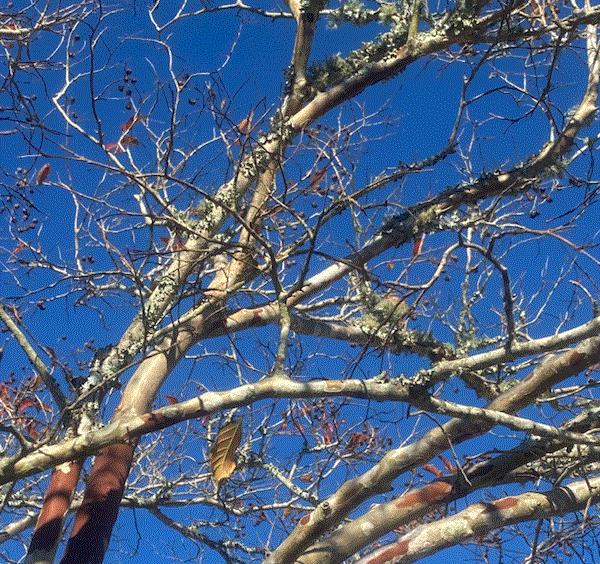
Although lichens don’t harm trees directly, they indicate some other issues. Lichens usually appear on tree branches that are exposed to the sun and rain, which to me means that the affected tree canopy is thinning. Perhaps the tree needs an invigorating prune. Or a number of other factors cause the thinning canopy. For anyone bothered by lichen on their trees, finding out what’s causing the canopy to thin is a better management approach than trying to peel off every piece of lichen on the bark.
Someone asked me during a talk last week if scale insects grow under the lichens. I can see that—a scale insect may find the shelter provided by the loose mat of a lichen to be a protected habitat. But I don’t think scale insects actively seek out lichens. Some scale insects have a special, symbiotic relationship with a group of fungi called septobasidium. (Click HERE for this newsletter from April 2021 where I discussed the symbiosis between armored scale insects and septobasidium.)
If y’all are now completely fascinated by lichens, I recommend a great information page from the U.S. Forest Service HERE. You’ll be fascinated by how complex and important lichens actually are!




See y'all later!

JC Chong
Professor of Entomology at Clemson University
This e-mail received by 26,984 subscribers like you!
If you're interested in advertising on PestTalks contact Kim Brown ASAP!